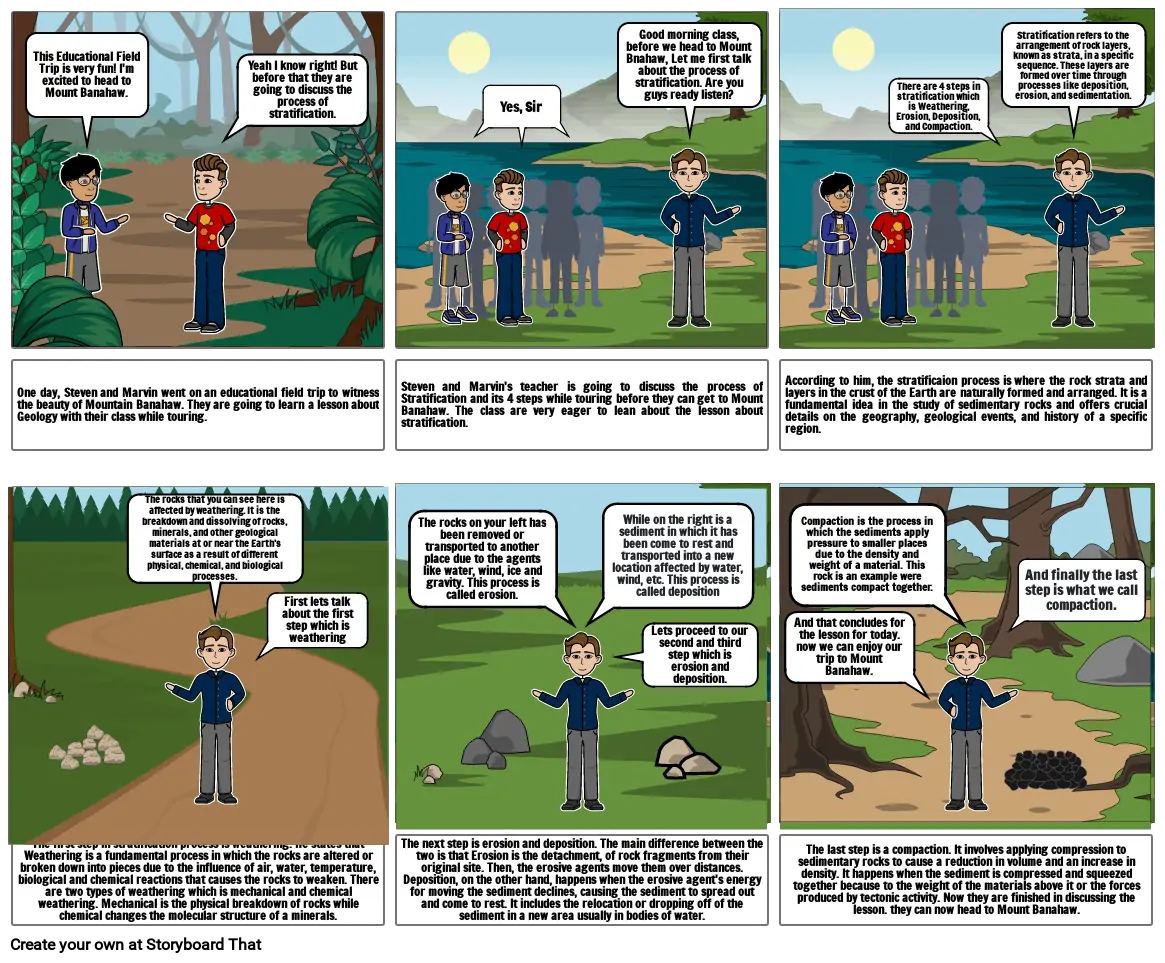Si Rina at ang kaniyang Aso

Testo Storyboard
- This Educational Field Trip is very fun! I'm excited to head to Mount Banahaw.
- Yeah I know right! But before that they are going to discuss the process of stratification.
- Yes, Sir
- Good morning class, before we head to Mount Bnahaw, Let me first talk about the process of stratification. Are you guys ready listen?
- There are 4 steps in stratification which is Weathering, Erosion, Deposition, and Compaction.
- Stratification refers to the arrangement of rock layers, known as strata, in a specific sequence. These layers are formed over time through processes like deposition, erosion, and sedimentation.
- One day, Steven and Marvin went on an educational field trip to witness the beauty of Mountain Banahaw. They are going to learn a lesson about Geology with their class while touring.
- The rocks that you can see here is affected by weathering. It is the breakdown and dissolving of rocks, minerals, and other geological materials at or near the Earth's surface as a result of different physical, chemical, and biological processes.
- First lets talk about the first step which is weathering
- Steven and Marvin's teacher is going to discuss the process of Stratification and its 4 steps while touring before they can get to Mount Banahaw. The class are very eager to lean about the lesson about stratification.
- The rocks on your left has been removed or transported to another place due to the agents like water, wind, ice and gravity. This process is called erosion.
- While on the right is a sediment in which it has been come to rest and transported into a new location affected by water, wind, etc. This process is called deposition
- Lets proceed to our second and third step which is erosion and deposition.
- According to him, the stratificaion process is where the rock strata and layers in the crust of the Earth are naturally formed and arranged. It is a fundamental idea in the study of sedimentary rocks and offers crucial details on the geography, geological events, and history of a specific region.
- And that concludes for the lesson for today. now we can enjoy our trip to Mount Banahaw.
- Compaction is the process in which the sediments apply pressure to smaller places due to the density and weight of a material. This rock is an example were sediments compact together.
- And finally the last step is what we call compaction.
- The first step in stratification process is weathering. He states that Weathering is a fundamental process in which the rocks are altered or broken down into pieces due to the influence of air, water, temperature, biological and chemical reactions that causes the rocks to weaken. There are two types of weathering which is mechanical and chemical weathering. Mechanical is the physical breakdown of rocks while chemical changes the molecular structure of a minerals.
- The next step is erosion and deposition. The main difference between the two is that Erosion is the detachment, of rock fragments from their original site. Then, the erosive agents move them over distances. Deposition, on the other hand, happens when the erosive agent's energy for moving the sediment declines, causing the sediment to spread out and come to rest. It includes the relocation or dropping off of the sediment in a new area usually in bodies of water.
- The last step is a compaction. It involves applying compression to sedimentary rocks to cause a reduction in volume and an increase in density. It happens when the sediment is compressed and squeezed together because to the weight of the materials above it or the forces produced by tectonic activity. Now they are finished in discussing the lesson. they can now head to Mount Banahaw.
Oltre 30 milioni di storyboard creati

